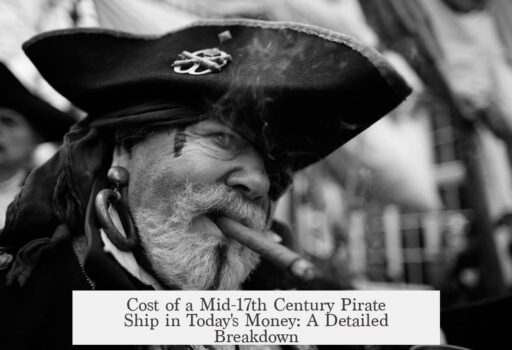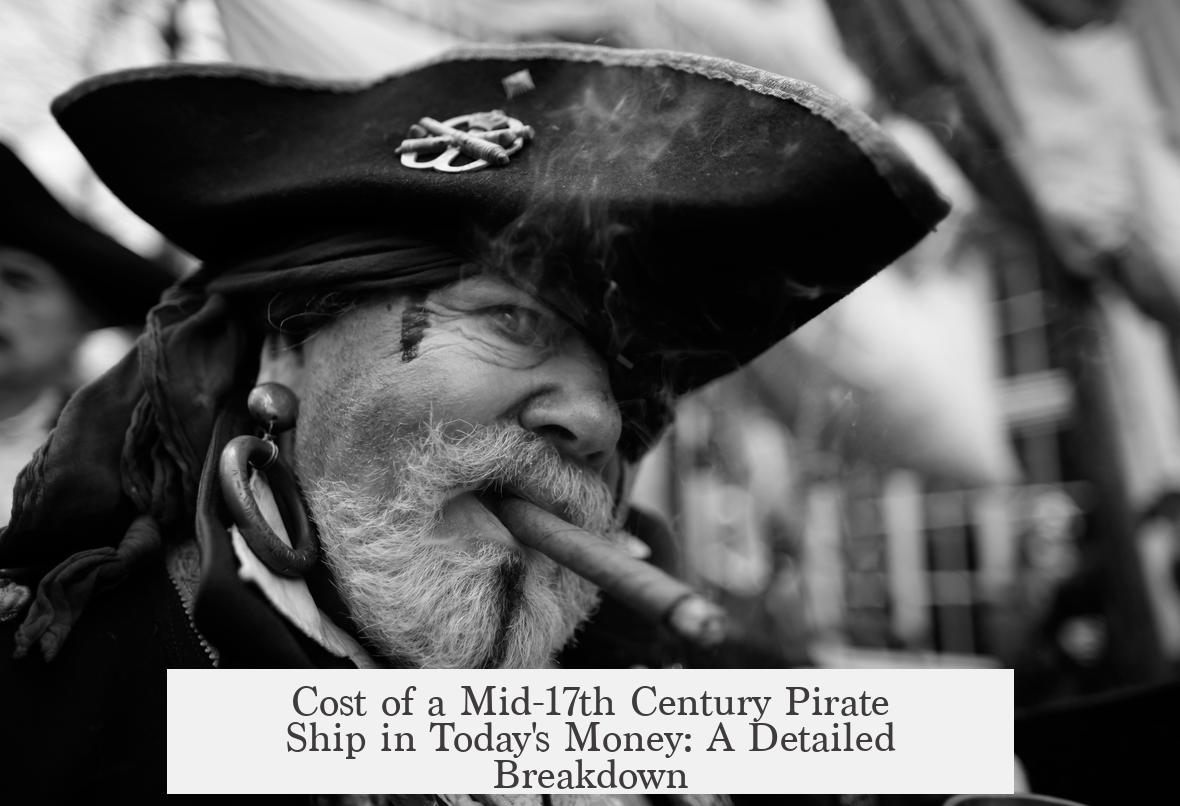A mid 17th century privateer or pirate ship would cost roughly 1 English Pound per ton in its own time. Translating that into today’s money is complex, but based on historical wages and modern shipbuilding examples, such a ship’s equivalent cost today would likely range between $1.5 million and $16 million USD, depending on size, construction methods, and intended use.

Admiralty records from the 17th century indicate privateer and pirate sloops—small and agile vessels preferred for their speed and maneuverability—had a purchase price of about one pound per ton. For example, a typical pirate sloop weighing 100 tons would cost 100 pounds then. Compared to larger ships such as East-Indiamen, which cost roughly £12,000, these sloops were quite affordable. However, their value varied widely depending on size, armament, and outfitting.
Evaluating the historical cost in today’s terms introduces challenges. Currency values, inflation, and economic contexts have changed considerably over centuries. A straightforward inflation adjustment may misrepresent relative purchasing power. Instead, wage-based comparisons provide insight: pre-industrial manual labor wages translate roughly to $11 per hour today, a parity supported by economic studies. Given that, 1 pound per ton then translates to an approximate labor-value equivalent, but this cannot fully account for material, construction, or technological gaps.

Large Dutch trading flutes in the 17th century cost approximately 10,000 guilders, with the largest ships built for the Dutch East India Company (VOC) reaching 100,000 guilders. In parallel, Royal Navy ships of the line cost tens of thousands of pounds sterling (e.g., first-rate ships ranged from £33,000 to £39,000), reflecting the upper range of naval investment at the time.
Today, reconstructing or building ships that resemble 17th-century vessels comes with varied price tags depending on authenticity and scale:

- The Bluenose II schooner rebuild has a price tag around $16 million Canadian dollars, reflecting full-scale traditional craftsmanship.
- The 2002 refit of the HMS Bounty replica cost about $1.5 million USD, a simpler restoration project.
- Other tall ship projects, such as the Spirit of South Carolina, have cost approximately $4.5 million.
These costs reflect modern materials, skilled labor, compliance with safety standards, and niche market production with low competition. Modern conveniences such as power tools and improved engineering can reduce both cost and build time compared to the original labor-intensive, hand-crafted methods of the 17th century.
Several factors affect historical and modern costs:

- Variable material costs: Different woods and components varied in price and availability, impacting construction expenses.
- Labor intensity: Felling timber and shaping ship components by hand was time-consuming, increasing labor value.
- Construction difficulty: Complexity of design, size of hold, number of cannons, and sails affected resource and labor needs.
- Operational expenses: Ships required ongoing maintenance, with costs reaching significant sums (e.g., mid-18th century first-rate Royal Navy ships cost £13,000 per month to maintain).
- Depreciation: Ships typically lasted up to 20 years before being scrapped, leading to amortized cost considerations.
Privateer vessels usually differed from pirate ships, potentially being larger and better armed, which would have increased costs historically and today. Pirates typically used smaller sloops and requisitioned trading ships which were cheaper to obtain and operate.
Conversion methodologies include:

- Inflation-adjusted currency conversions
- Purchasing power parity (PPP) adjustments
- Wage-based value comparisons
- Cost comparison with contemporary equivalents
Each approach yields different cost estimates, highlighting the difficulties in making exact modern comparisons. The wage-based method offers practical utility, equating labor value across centuries to approximate costs. It suggests that manual labor’s relative cost hasn’t drastically changed since the 18th century, lending some stability to cost estimates from their historical basis.
Modern shipbuilding for these types of vessels remains specialized, with limited production volume and market demand contributing to high costs compared to mass-produced yachts or commercial vessels. Authenticity requirements also add complexity and expense.

| Ship Type / Example | 17th Century Cost | Modern Equivalent Cost |
|---|---|---|
| Typical Pirate Sloop (100 tons) | ~£100 (1 pound/ton) | Estimated $1.5M – $4.5M USD (rebuild/replica range) |
| East-Indiaman | ~£12,000 | Higher end of replica build, potentially $10M+ |
| Large Dutch Flute | 10,000 guilders | N/A (varied production costs) |
| HMS Bounty Replica Refit (2002) | N/A | ~$1.5 million USD |
| Bluenose II Schooner Rebuild | N/A | ~$16 million CAD |
In summary, a mid 17th century pirate or privateer ship’s cost in today’s money ranges widely based on interpretation and intended use. Historically, around 1 pound per ton was a guiding estimate. Translating that directly to modern USD suggests low millions for small sloops, escalating substantially for larger, ornate replicas or vessels built with traditional techniques.
- Historical cost roughly 1 English pound per ton for pirate/privateer sloops.
- Today’s equivalent spans $1.5M to $16M depending on size and methods.
- Wage-value comparisons provide a more stable conversion than direct inflation.
- Modern shipbuilding costs are driven by niche markets and craftsmanship.
- Material, labor, size, and technology substantially influence final price.
How Much Would a Mid-17th Century Privateer/Pirate Ship Cost with Today’s Money?
Wondering just how deep you’d have to dig into your 21st-century pockets to afford a mid-17th century privateer or pirate ship? The short answer is: roughly 1 English Pound per ton in the 17th century, which when translated into today’s currency ranges widely from a few million to over $16 million, depending on many factors. Sounds vague? Well, buckle up, because navigating the seas of historical currency conversions is as tricky as outwitting a rival pirate captain.
Let’s set sail through the fascinating, and sometimes murky, waters of 17th-century ship prices, modern equivalents, and the wild economics of pirate vessels!
Historic Ship Costs: Anchoring Our Understanding in Guilders and Pounds
In the 1600s, shipbuilding wasn’t cheap — but just how expensive was it? Let’s peek into some records.
- A large Dutch flute—a type of merchant ship—went for about 10,000 guilders.
- The Dutch East India Company’s (VOC) massive ships could cost 100,000 guilders by mid-century.
- Across the English Channel, a first-rate Royal Navy ship, the top dog of the fleet, cost between £33,000 to £39,000.
- Typical third-rate ships settled around £15,000-17,000—still nothing to scoff at.
- An East-Indiaman merchant ship was priced around £12,000.
To put those in perspective, a respectable bureaucrat earned about 500 guilders annually—a handy backdrop to guess just how much gold they needed to chase a prize or command a vessel.
But How Do We Switch from 17th Century Pounds to Today’s Dollars?
This question trips up even the most daring economists. Inflation, market shifts, currency transformations—it’s enough to make your head spin. Remember, the value of money back then was tied to entirely different economic structures and priorities.
A clever method to measure “value” compares wages: taking the daily wage of a laborer in the 17th century and matching it to today’s labor wages. Using this yardstick, one day’s work then was roughly equivalent to $11/hour now. Applying this to ship prices offers one lens—but remember, it’s a rough sea to sail.
So, What Did a Pirate Ship Look Like in Price and Shape?
Most people imagine pirate ships as huge, cannon-packed leviathans—with Jolly Rogers flying dramatic and free—but the reality was often more modest.
- Typical pirate ships were often sloops: small, nimble one-masted vessels suitable for quick getaways and coastal raiding.
- Admiralty records suggest the purchase price averaged 1 English Pound per ton. A sloop could be anywhere from 50 to 150 tons, putting the price between £50 and £150.
As a playful example, imagine a 100-ton sloop costing £100. Adjust that with labor wage comparisons, and you might be looking at a few hundred thousand dollars today—if you want an approximate figure.
Hold On—Building a Pirate Ship Today: What’s the Cost?
Imagine you want to build your own pirate ship replica today. The numbers might surprise you.
- The famous schooner Bluenose II’s rebuild price is about $16 million CAD.
- The 2002 refit of the HMS Bounty replica cost approximately $1.5 million USD.
- A smaller vessel, the Spirit of South Carolina, reached $4.5 million to build.
The variation is vast because modern replicas might use a mix of traditional craftsmanship and modern tools. Power tools streamline work, but original wooden shipbuilding is labor-intensive and pricey.
Keeping a tall ship sailing today also dents the wallet: several hundred thousand dollars a year go into maintenance, crew wages, and repairs. Back in the 18th century, the Royal Navy spent £13,000 a month just maintaining a first-rate ship like HMS Victory, reminding us that ship upkeep has never been a cheap pastime.
What Drives the Cost? From Timber and Nails to Sail Size
Several factors influenced how much a pirate or privateer ship cost, beyond just base tonnage.
- Materials: Good quality wood was vital. Hardwood like oak was prized, but even nails were scarce enough to be considered booty!
- Labor: Trees were felled with axes and saws, transported by hand, and crafted by skilled shipwrights—all time-consuming work.
- Design Choices: How large of a hold did you want? More cabins meant higher costs. Cannons inflated prices. The higher your sails, the more complex and costly the rigging.
You might say, “A pirate ship is just a floating box,” but it’s more like a floating Swiss Army knife—with each tool adding weight to the cost.
Privateers and Pirates: Different Ships, Different Budgets?
Fun fact: privateers and pirates weren’t exactly the same. Privateers had government backing and often employed more official, sometimes larger, vessels to wage sea warfare with legal permission.
Pirates, on the other hand, tended to favor smaller, faster ships easy to capture and maintain on the spur of the moment.
Modern Economy VS. 17th Century Economy: Apples and Cannonballs
The question “how much would it cost today?” seems straightforward but isn’t so simple. What do we mean by “today’s money”?
- Is it simply inflation-adjusted price?
- Purchasing Power Parity (PPP) adjustments?
- GDP percentage or number of labor days converted to today’s wages?
Each method gives a very different answer, much like choosing between a Dutch guilder and English pound back then.
An easy guess? You’d need at least a few million dollars for a mid-sized, mid-17th century style pirate sloop today—and that’s after you factor in what modern skill and technology can save you.
Lessons for Writers, Gamers, and Curious Minds
So, if you’re writing that swashbuckling novel or designing a pirate-themed RPG, this is your quick-and-dirty figure:
“Around 1 English Pound per ton back then, roughly equal to a few million dollars today for a typical pirate sloop.”
Need more detailed cost info and ideas? Check out RPG sourcebooks, like GURPS Swashbucklers, which deep dive into economics, ship costs, and more!
Is Owning a Pirate Ship Cheaper Than Yacht Ownership?
One might wonder: aren’t yachts also expensive? Modern replica ships with more charm and less speed can, however, cost even more than many yachts due to the niche market and craftsmanship needed.
Without a mass-production system, these beauties are rare trophies, coming with impressive price tags. With some ingenuity, though, a power-tool-enhanced build could make it closer to the cost of a large yacht.
To Sum It Up: Pirate Ship Pricing, 17th Century vs. Today
| Ship Type | 17th Century Cost | Estimated Modern Equivalent |
|---|---|---|
| Typical pirate sloop (e.g., 100 tons) | £100 (1 £ per ton) | Approx. $1 million – $4 million USD* |
| Large East Indiaman | £12,000 | Many tens of millions USD (comparing fleet costs) |
| Bluenose II Replica | Modern ship | $16 million CAD |
| HMS Bounty Replica Refit (2002) | N/A | $1.5 million USD |
| Spirit of South Carolina (recent) | N/A | $4.5 million USD |
*Based on wage and inflation conversion methods, estimates vary widely.
Final Thoughts
How much would a mid-17th century pirate ship cost today? It depends on your pirate ambitions, construction methods, and whether you want authenticity or efficiency. While raw numbers from 1 English Pound per ton give us a compass point, modern reality adds variables like labor, niche market pricing, and maintaining the beast once built.
For those captivated by history and adventure, understanding these economic tides enriches the stories of the high seas. After all, the true cost of piracy isn’t always gold—it’s the effort, danger, and skill at sea!




